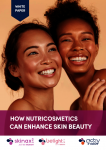Top three stories this week
Topical anti-cancer drug could have anti-aging potential
Topical application of the drug fluorouracil is used to reduce potentially precancerous skin patches called actinic keratoses, according to the study published in the Archives of Dermatology.
After such treatment, improvements have been seen in photoaged skin, write the authors led by Dana Sachs at the University of Michigan, leading to the current study that attempts to characterise in more detail these potentially positive side effects.
In the course of the study, 19 patients applied 5 percent fluorouracil cream to the face twice daily for two weeks and changes to the skin were evaluated in the six months following the start of the treatment.
According to the researchers, fine and coarse wrinkles, and age spots, were seen to improve from baseline levels, and at the end of the study all of the patients reported their skin texture to be improved.
The study also investigated the biochemical changes in the skin during and after treatment and the scientists suggested that fluorouracil’s effect is the result of its potential to damage the skin and then illicit a wound healing response.
Like many other treatments that rely on this mechanism, such as laser resurfacing or microdermabrasion, the cream is associated with significant inflammation of the skin before the healing process sets in.
Twelve of the nineteen patients reported the treatment to be very or moderately uncomfortable, said the scientists. However, 17 said they would be willing to undergo the treatment again.
The authors conclude that for patients who have been prescribed a course of fluorouracil for the treatment of actinic keratoses, the positive anti-aging side effects might help motivate them to stick to the rigorous treatment.
In addition they conclude that: “Undoubtedly, there will be patients who desire a therapy such as topical fluorouracil of cosmetic purposes given the relatively low cost of this therapy compared with ablative laser resurfacing.”
Furthermore, the authors suggest that other topical agents such as diclofenac gel or imiquimod that have similar skin injuring properties in photodamaged skin may lead to similar improvements.
Source: Archives of DermatologyVolume 145, number 6, June 2009Topical fluorouracil for actinic keratoses and photoagingDana L Sachs, Sewon Kang, Craig Hammerberg, Yolanda Helfrich, Daruis Karimipour, Jeffrey Orringer, Timothy Johnson, Ted A Hamilton, Gary Fisher, John J Voorhees










